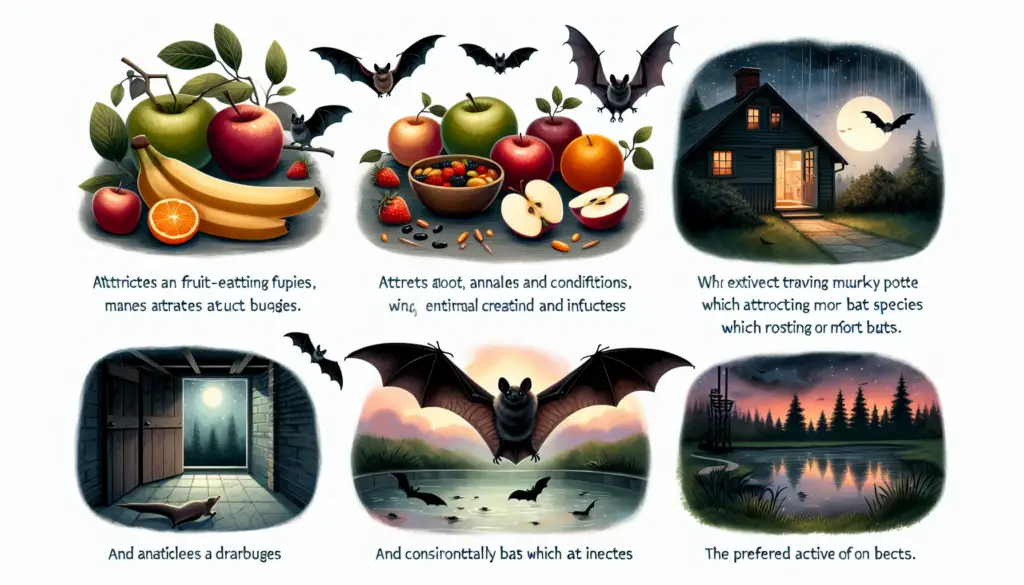Bats are attracted to your house due to the availability of shelter, abundant insects for food, and environmental factors that make your home a suitable roosting site.
Why Shelter Draws Bats to Your Home
Table of Contents
ToggleBats seek out safe and quiet places to roost during the day.
Your attic, chimney, or even wall cavities can provide the perfect shelter for them.
These areas mimic the natural habitats bats use, like caves and hollow trees.
Small openings or cracks in the exterior of your house can serve as entry points for bats.
They prefer spaces that are warm and undisturbed, which makes attics ideal.
If there are gaps in your roofing or siding, bats might find their way inside.
Abundant Insect Population Around Your Home
If your property has a high number of insects like mosquitoes, moths, and beetles, it can attract bats.
Bats are insectivores and can eat hundreds of insects in an hour.
A lush garden or nearby water sources can increase insect populations, making your home attractive to bats.
Outdoor lighting can also draw insects.
Bats may be attracted to your house because the lights bring in their prey.
Reducing excessive outdoor lighting can help decrease the number of insects and, consequently, bats.
Environmental Factors That Attract Bats
Properties located near forests, parks, or bodies of water are more likely to attract bats.
These environments are natural habitats for bats and provide ample food and shelter options.
If your house is in such an area, you might experience more bat activity.
Warm climates or houses that retain heat can be appealing to bats.
They are warm-blooded mammals and prefer roosting in warmer places to raise their young.
Ensuring your home is well-insulated and sealing heat leaks can make it less inviting to bats.
Some bats, like the Greater Horseshoe Bat, prefer these environments.
Common Entry Points for Bats
Bats can squeeze through very small openings, sometimes as tiny as half an inch.
Small species like the Bumblebee Bat can fit through even smaller spaces.
Common entry points include gaps in roofing shingles, vents without screens, and cracks in the siding.
Regularly inspecting your home for these openings can prevent bats from getting inside.
Chimneys without caps are easy access points for bats.
Installing a chimney cap can help keep bats and other wildlife out.
It is a simple fix that can save you a lot of trouble down the line.
Fruit Trees and Gardens
If you have fruit trees or a garden, bats might be attracted to your property.
While many bats eat insects, some species feed on fruit and nectar, like the Hammer-Headed Bat.
Having these food sources available can draw bats closer to your home.
Maintaining your garden and picking ripe fruit promptly can reduce this attraction.
Removing fallen fruit from the ground can also help.
This simple garden upkeep can make your property less appealing to bats.
Outdoor Water Sources
Ponds, birdbaths, or standing water can attract bats.
They need water for drinking and as a habitat for insects they eat.
Eliminating standing water and maintaining water features can reduce bat activity.
Consider installing a water fountain or aerator in ponds to keep the water moving.
This can reduce insect breeding and make the area less attractive to bats.
Proper drainage around your property can also help.
Unmanaged Attics and Eaves
An attic that is not frequently accessed can be a perfect spot for bats.
They look for quiet, undisturbed areas to roost.
Checking your attic periodically can help you spot signs of bats early.
Secure any openings in your eaves and use fine mesh to cover vents.
This prevents bats from entering while still allowing your home to breathe.
It is an effective way to bat-proof your attic.
Attracting Bats Away with a Bat House
Installing a bat house can provide bats with an alternative roosting spot.
Place it away from your home to encourage bats to settle elsewhere.
This can help reduce the number of bats trying to roost in your house.
Bat houses should be mounted at least 12 to 20 feet off the ground.
They need to be in a location that gets plenty of sunlight during the day.
Proper installation increases the chances that bats will use the bat house instead of your attic.
One product that might help is the “Cedar Bat House”.
It is made from weather-resistant cedar wood and designed to attract bats by providing an ideal roosting environment.
Pros
- Durable cedar wood construction.
- Easy to install.
- Provides a natural roosting spot for bats.
Cons
- May require regular maintenance.
- Results can vary depending on location.
Find This and More on Amazon
Using Bat Repellents
There are various bat repellents available that can help deter bats from your home.
Ultrasonic devices emit sounds that are unpleasant to bats but inaudible to humans.
Placing these devices near entry points can discourage bats from entering.
Natural repellents like essential oils may also work.
Bats dislike strong smells such as peppermint or eucalyptus.
Spraying these oils around potential entry points can help keep bats away.
Find This and More on Amazon
Adjusting Outdoor Lighting
Switching to yellow or red outdoor lighting can reduce the number of insects attracted to your home.
Traditional white lights draw in insects, which in turn attract bats.
Using “bug lights” or motion-activated lighting can help minimize this effect.
One product to consider is the “Yellow Bug Light Bulb”.
It is designed to emit a warm light that is less attractive to insects.
Pros
- Reduces insect attraction.
- Energy-efficient options available.
- Easy to install in existing fixtures.
Cons
- Light color may be less desirable for some applications.
- May not eliminate insects entirely.
Find This and More on Amazon
Professional Wildlife Removal Services
If you have a significant bat problem, it might be time to call professionals.
Wildlife removal experts can safely remove bats and seal entry points.
They have the experience and equipment to handle bats humanely.
Attempting to remove bats yourself can be risky.
Bats can carry diseases like rabies.
Professionals can ensure that bats are removed without harm to you or the bats.
Legal Protection of Bats
It is important to know that bats are protected by law in many areas.
Certain species are endangered and cannot be harmed.
Before taking any action, check local regulations regarding bat removal.
Usually, exclusion methods are preferred over extermination.
This involves sealing entry points after bats have left to prevent re-entry.
It is a humane way to handle bat infestations.
Preventing Future Bat Attractions
Regular home maintenance can prevent bats from being attracted to your house.
Sealing cracks, fixing screens, and installing chimney caps are effective measures.
Keeping your property well-lit can also deter bats.
Controlling the insect population around your home reduces the food source for bats.
Using yellow or red outdoor lights can attract fewer insects.
This, in turn, makes your home less appealing to bats.
Just as bats are attracted to your home for food and shelter, other wildlife may also find your property appealing.
Knowing why deer display certain behaviors can help you manage your property to discourage unwanted visitors.
Learning More About Bat Behavior
Understanding why bats are attracted to your home can help you prevent it.
Bats play a crucial role in the ecosystem by controlling insect populations.
Encouraging them to roost away from your home benefits both you and the bats.
You might find it interesting to learn about different bat species.
The variety of bats includes species like the Mexican Free-Tailed Bat and the Vampire Bat.
Knowing more about them can help you coexist peacefully.
Understanding different bat species, such as the Bulldog Bat, can help in identifying which bats are around your home.
Bats play a vital role in controlling insects, much like deer impact their environment.
Learning about deer biology can enhance your appreciation for local wildlife.
In managing your property to reduce bat attractions, you might also consider impacts on other wildlife.
For instance, understanding deer habitat requirements can help you make informed decisions about landscaping.
You can find more information about bats and their behavior at worlddeer.org/animals/bats/.



